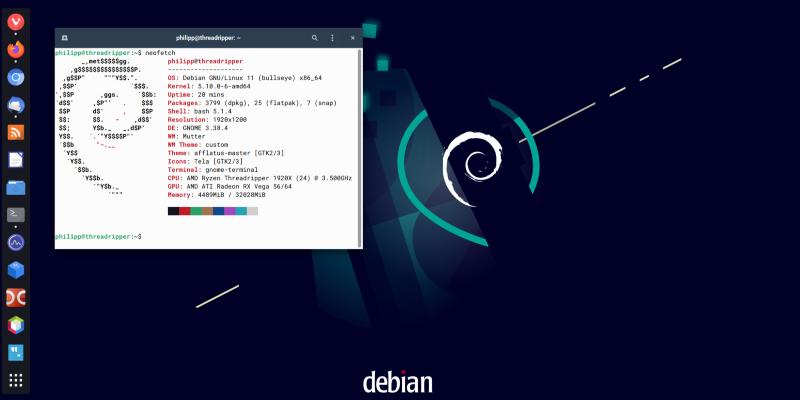Debian Edu / Skolelinux Bullseye — a complete Linux solution for your school
------------------------------------------------------------------------
The Debian Project https://www.debian.org/
Debian Edu / Skolelinux Bullseye — a complete
Linux solution for your school press@debian.org
August 15th, 2021 https://www.debian.org/News/2021/20210815
------------------------------------------------------------------------
Are you the administrator for a computer lab or an entire school network? Would you like to install servers, workstations, and laptops to work together? Do you want the stability of Debian with network services already preconfigured? Do you wish to have a web-based tool to manage systems and several hundred or even more user accounts? Have you asked yourself if and how older computers could be used?
Then Debian Edu is for you. The teachers themselves or their technical support can roll out a complete multi-user multi-machine study environment within a few days. Debian Edu comes with hundreds of applications pre-installed, and you can always add more packages from Debian.
The Debian Edu developer team is happy to announce Debian Edu 11 "Bullseye", the Debian Edu / Skolelinux release based on the Debian 11 "Bullseye" release. Please consider testing it and reporting back () to help us to improve it further.
About Debian Edu and Skolelinux
-------------------------------
Debian Edu, also known as Skolelinux [1], is a Linux distribution based on Debian providing an out-of-the box environment of a completely configured school network. Immediately after installation, a school server running all services needed for a school network is set up just waiting for users and machines to be added via GOsa², a comfortable web interface. A netbooting environment is prepared, so after initial installation of the main server from CD / DVD / BD or USB stick all other machines can be installed via the network. Older computers (even up to ten or so years old) can be used as LTSP thin clients or diskless workstations, booting from the network without any installation and configuration at all. The Debian Edu school server provides an LDAP database and Kerberos authentication service, centralized home directories, a DHCP server, a web proxy and many other services. The desktop environment contains more than 70 educational software packages and more are available from the Debian archive. Schools can choose between the desktop environments Xfce, GNOME, LXDE, MATE, KDE Plasma, Cinnamon and LXQt.
1: https://blends.debian.org/edu
New features for Debian Edu 11 "Bullseye"
-----------------------------------------
These are some items from the release notes for Debian Edu 11 "Bullseye", based on the Debian 11 "Bullseye" release. The full list including more detailed information is part of the related Debian Edu manual chapter [2].
* New LTSP [3] to support diskless workstations. Thin clients are still supported, now using X2Go [4] technology.
* Booting over the network is provided using iPXE instead of PXELINUX to be compliant with LTSP.
* The Debian Installer's graphical mode is used for iPXE installations.
* Samba is now configured as "standalone server" with support for SMB2/SMB3.
* DuckDuckGo is used as default search provider for both Firefox ESR and Chromium.
* New tool added to set up freeRADIUS with support for both EAP-TTLS/PAP and PEAP-MSCHAPV2 methods.
* Improved tool available to configure a new system with "Minimal" profile as dedicated gateway.
2: https://wiki.debian.org/DebianEdu/Documentation/Bullseye/Features#New_features_in_Debian_Edu_Bullseye
3: https://ltsp.org
4: https://wiki.x2go.org
Download options, installation steps and manual
-----------------------------------------------
Official Debian Network-Installer CD images for both 64-bit and 32-bit PCs are available. The 32-bit image will only be needed in rare cases (for PCs older than around 15 years). The images can be downloaded at the following locations:
* http://get.debian.org/cdimage/release/current/amd64/iso-cd
* http://get.debian.org/cdimage/release/current/i386/iso-cd
Alternatively official Debian BD images (more than 5 GB in size) are also available. It is possible to set up a whole Debian Edu network without an Internet connection (including all desktop environments and localization for all languages supported by Debian). These images can be downloaded at the following locations:
* http://get.debian.org/cdimage/release/current/amd64/iso-bd
* http://get.debian.org/cdimage/release/current/i386/iso-bd
The images can be verified using the signed checksums provided in the download directory. Once you've downloaded an image, you can check that its checksum matches that expected from the checksum file; and that the checksum file has not been tampered with. For more information about how to do these steps, read the verification guide [5].
5: https://www.debian.org/CD/verify
Debian Edu 11 "Bullseye" is entirely based on Debian 11 "Bullseye" ; so the sources for all packages are available from the Debian archive.
Please note the Debian Edu Bullseye status page [6]. for always up-to-date information about Debian Edu 11 "Bullseye" including instructions how to use rsync for downloading the ISO images.
6: https://wiki.debian.org/DebianEdu/Status/Bullseye
When upgrading from Debian Edu 10 "Buster" please read the related Debian Edu manual chapter [7].
7: https://wiki.debian.org/DebianEdu/Documentation/Bullseye/Upgrades
For installation notes please read the related Debian Edu manual chapter [8].
8: https://wiki.debian.org/DebianEdu/Documentation/Bullseye/Installation#Installing_Debian_Edu
After installation you need to take these first steps [9].
9: https://wiki.debian.org/DebianEdu/Documentation/Bullseye/GettingStarted
Please see the Debian Edu wiki pages [10] for the latest English version of the Debian Edu "Bullseye" manual. The manual has been fully translated to German, French, Italian, Danish, Dutch, Norwegian Bokmål, Japanese, Simplified Chinese and Portuguese (Portugal). Partly translated versions exist for Spanish, Romanian and Polish. An overview of the latest published versions of the manual [11] is available.
10: https://wiki.debian.org/DebianEdu/Documentation/Bullseye/
11: https://jenkins.debian.net/userContent/debian-edu-doc/
More information about Debian 11 "Bullseye" itself is provided in the release notes and the installation manual; see https://www.debian.org/.
About Debian
------------
The Debian Project is an association of Free Software developers who volunteer their time and effort in order to produce the completely free operating system Debian.
Contact Information
-------------------
For further information, please visit the Debian web pages at https://www.debian.org/
The Debian Edu developer team has announced the release of Debian Edu / Skolelinux Bullseye.

